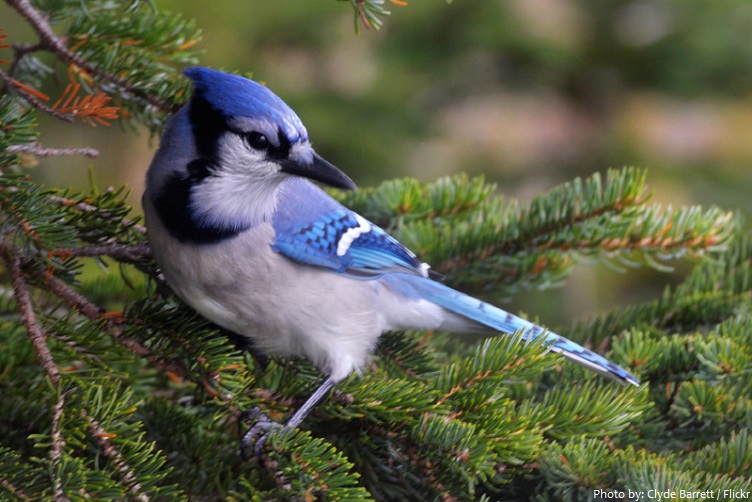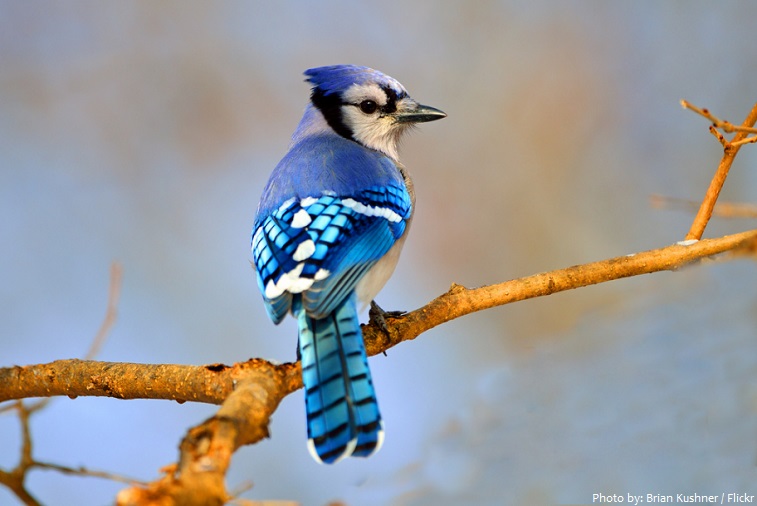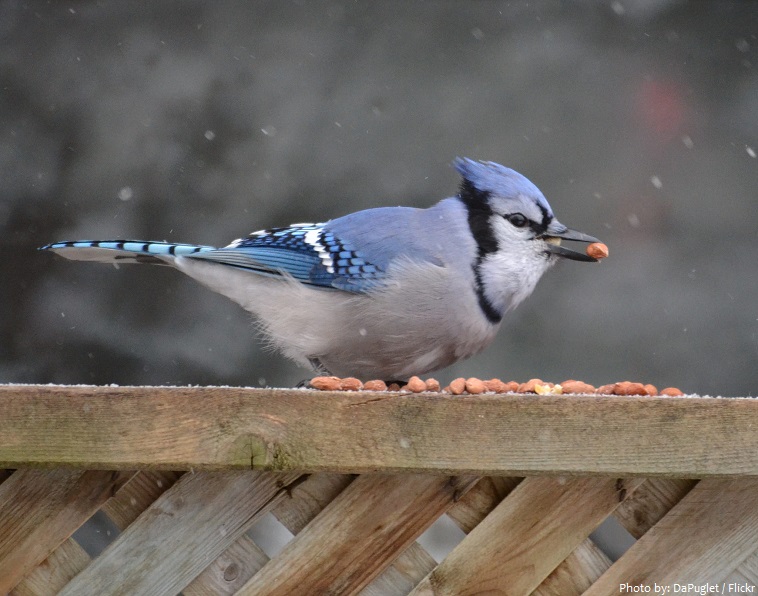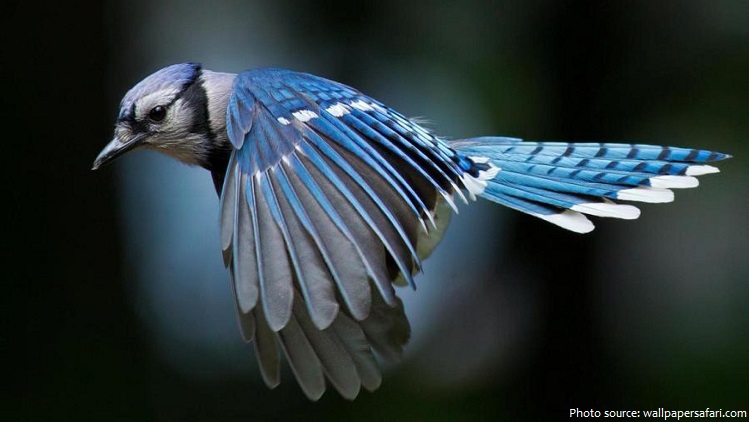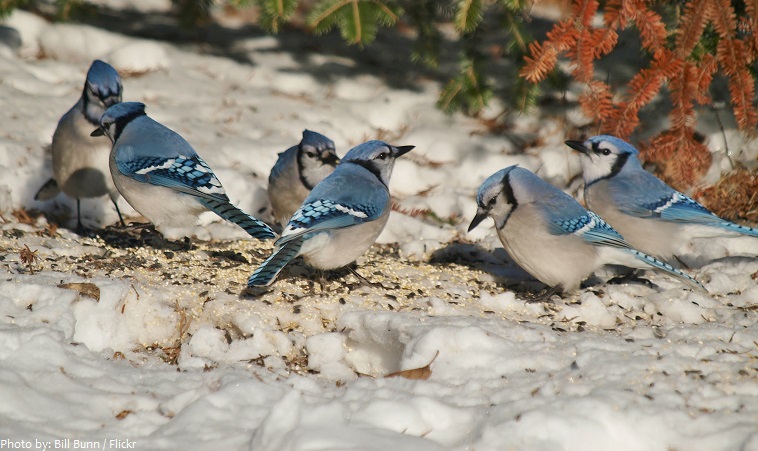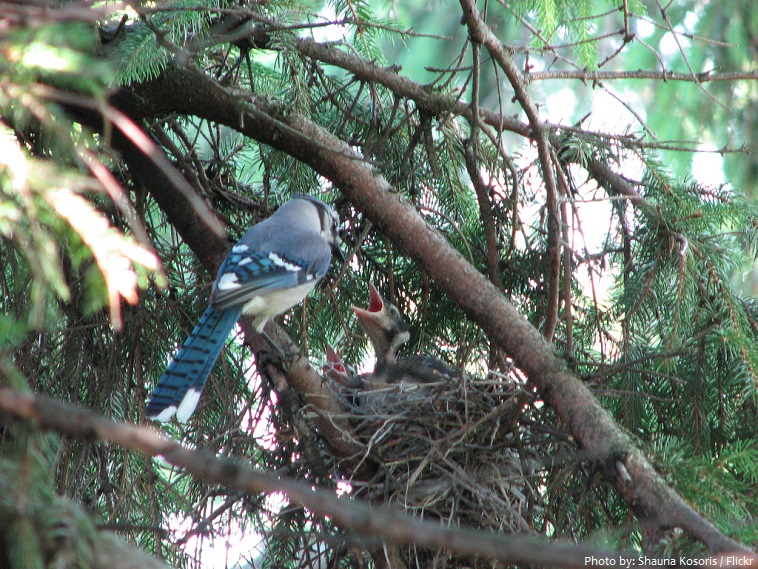The blue jay (Cyanocitta cristata) is a songbird that belongs to the family Corvidae.
They are native to forests of the eastern United States.
Blue jays live in deciduous, coniferous and mixed forests throughout the eastern and central areas of the United States, and southern Canada. They also can be found in parks and suburban residential areas, and are frequent guests of backyard bird feeders.
Blue jays have been recorded to live for more than 26 years in captivity and one wild jay was found to have been around 17 and a half years old.
However, the average lifespan is 7 years in the wild.
The blue jay measures 22–30 cm (9–12 inches) from bill to tail and weighs 70–100 g (2.5–3.5 oz), with a wingspan of 34–43 cm (13–17 in).
There is a pronounced crest on the head, a crown of feathers, which may be raised or lowered according to the bird’s mood. When the crest is raised, making a prominent peak, the bird is excited, surprised, or aggressive. If the jay is frightened, the crest bristled out in all directions. If the bird is relaxed, the crest is laid flat on the head.
Its plumage is lavender-blue to mid-blue in the crest, back, wings, and tail. Their face is typically white, and they have an off-white underbelly. They have a black-collared neck, and the black extends down the sides of their heads – their bill, legs, and eyes are also all black. The main wing and tail feathers are deep with black, sky-blue and white. Males and females are almost identical, but the male is slightly larger.
As with most other blue-hued birds, the blue jay’s coloration is not derived from pigments but is the result of light interference due to the internal structure of the feathers; if a blue feather is crushed, the blue disappears because the structure is destroyed.
The molting of the feathers all over the body and wings for the blue jay lasts about six weeks, between June and July. During this process the skin is covered, but the coating is not very thick.
Blue jays are omnivores. They eats fruits and other berries, acorns, seeds, nuts, insects, mice, frogs and rarely eggs and nestlings.
When a blue jay eats nuts, it holds the nut with its feet and cracks it open with its bill.
The blue jay is a seed spreader. It often buries food to eat later. Some seeds and nuts are never recovered and grow into trees and other plants!
The blue jay is very aggressive and territorial. Groups of blue jays often attack intruders and predators. They often drive other birds away from bird feeders.
The blue jay is a moderately slow flier (roughly 32–40 km/h (20–25 mph)) when unprovoked. It flies with body and tail held level, with slow wing beats. Due to its slow flying speeds, this species makes easy prey for hawks and owls when flying in open areas.
Blue jays are very vocal birds. They can make a large variety of sounds. The common call is a harsh, jeering jaay or jay-jay, for which it is named. They are known to mimic the sound of hawks – these calls inform other jays that a hawk is present, or may be used to deceive other species into believing a hawk is present. They may also learn to mimic human speech.
They are fairly social and are typically found in pairs or in family groups or small flocks.
It is a partially migratory bird, particularly in the northern parts of its range.
It migrates during the daytime and join in large flocks of up to 250 birds to make the long journey. Much about their migratory behavior remains a mystery. Some are present throughout winter in all parts of their range. Some individual jays migrate south one year, stay north the next winter, and then migrate south again the next year. To date, no one has concretely worked out why they migrate when they do.
Blue jays form long-lasting, monogamous pair bonds. These bonds usually last until one of the pair dies.
The mating season begins in mid-March, peaks in mid-April to May, and extends into July.
The male and female both help to build the nest and the male remains with the female to feed her throughout courtship and incubation of the eggs.
There are usually between 3 and 6 (averaging 4 or 5) eggs laid and incubated over 16–18 days. The young fledge usually between 17–21 days after hatching.
Blue jays will actively defend their nests against predators. Both parents will attack and chase hawks, falcons, raccoons, cats, snakes, squirrels, and even humans away from their nests.
After the juveniles fledge, the family travels and forages together until early fall, when the young birds disperse to avoid competition for food during the winter.
Blue jay populations are on the rise, and they are often very common where they occur.
In old African American folklore of the southern United States, the blue jay was held to be a servant of the Devil, and “was not encountered on a Friday as he was fetching sticks down to Hell; furthermore, he was so happy and chirpy on a Saturday as he was relieved to return from Hell”.
The blue jay was adopted as the team symbol of the Toronto Blue Jays Major League Baseball team, as well as some of their minor league affiliates. Their mascot is Ace, also a blue jay.

